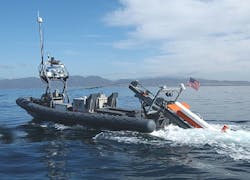Northrop Grumman demonstrates synthetic aperture sonar for undersea imaging at 18-knot speeds
ANNAPOLIS, Md., 15 Sept. 2015. Undersea warfare experts at Northrop Grumman Corp. have demonstrated the ability to perform synthetic aperture sonar signal processing at speeds as fast as 18 knots in real time, company officials announced Monday.
Sonar experts at the Northrop Grumman Undersea Systems segment in Annapolis, Md., demonstrated their company's AQS-24B mine-hunting system and its sonar signal processing during a U.S. Navy field test last May in the Persian Gulf off of Bahrain.
During testing the he AQS-24B finished 12 for 12 in missions, company officials say. The Navy can detect, classify and localize modern-day mine threats through the AQS-24B's enhanced mine-hunting sonar.
Synthetic aperture sonar uses sophisticated digital signal processing of sonar data to produce image of underwater objects such as mines and other obstructions. It moves the system while focusing its sonar energy on the same spot on the sea floor with several pings.
Synthetic aperture sonar artificially recreates the effects of a long sonar array. It uses data from several consecutive pings to synthesize a long sonar array, which improvies the sonar image resolution.
Related: NATO minehunting UUV relies on GPU-based embedded processor from GE for imaging sonar
A problem with synthetic aperture sonar has been the relatively slow speeds at which it must operate. Northrop Grumman experts have fine-tuned the system's signal processing to enable the AQS-24B to move at 18 knots.
During separates sea trials in Panama City, Fla., the AQS-24B operated continuously for 16.25 hours from a surface ship, officials say. The AQS-24B has improved image resolution, as well as the speed of real-time sonar processing.
"The AQS-24B represents a significant advancement of the U.S. Navy's mine hunting capability, on both the MH-53E helicopters as well as the Mine Hunting Unmanned Surface Vessels (MHOs)," says Alan Lye, vice president of Northrop Grumman Undersea Systems.
The Northrop Grumman Undersea Systems business unit is part of the Northrop Grumman Electronic Systems segment in Linthicum, Md. For more information contact Northrop Grumman Electronic Systems online at www.northropgrumman.com.

John Keller | Editor
John Keller is editor-in-chief of Military & Aerospace Electronics magazine, which provides extensive coverage and analysis of enabling electronic and optoelectronic technologies in military, space, and commercial aviation applications. A member of the Military & Aerospace Electronics staff since the magazine's founding in 1989, Mr. Keller took over as chief editor in 1995.

